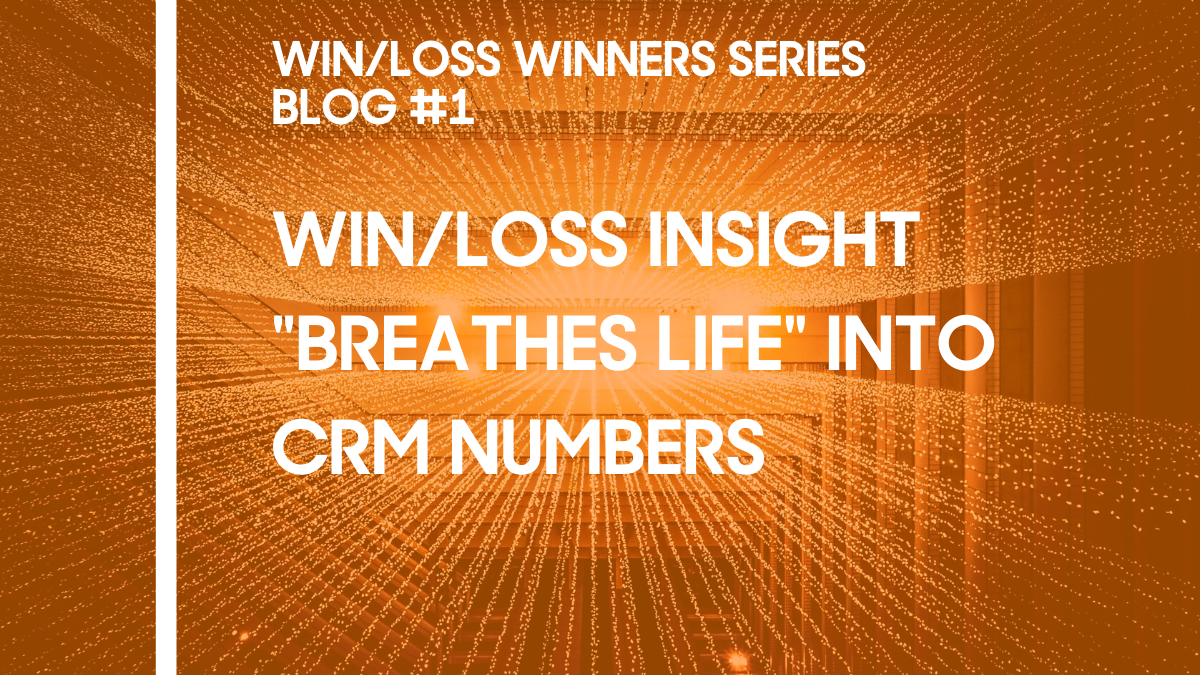Four Best Practices to Turn Win/Loss Insights Into Actionable and Measurable Change
AT A GLANCE
The Challenge
To drive organizational change, Benefitfocus understood that it was essential to expand its win/loss readership group beyond sales enablement and sales operations to include leadership, the RFP team, and the competitive intelligence team in order to take advantage of the wealth of knowledge gained from win/loss insights.
The Strategy
Even though sales is one of the most challenging stakeholders from which to gain buy-in, Benefitfocus has been successful at creating an appetite among sales staff for learning the most common win and loss themes, and for receiving feedback from win/loss research. During a national deal spotlight call that is held every month, a deal is dissected and the different stages of engagement are explained, along with the lessons learned.
The Pay Off
DoubleCheck win/loss research has revealed substantial findings, such as pricing challenges, new market threats, and prospecting gaps, among others. Having this wealth of knowledge has allowed the SaaS company to take concrete action, understand where it wins, where it loses, and, ultimately, solidify its position in the market.
“Maybe it’s a little bit hyperbolic, but win/loss data is something we can’t live without at this point. Win/loss takes numbers off of the page of a report that you can pull from a CRM, and it breathes life into them and gives specifics.”
—Sales enablement manager at Benefitfocus
The sales enablement team of a leading cloud-based provider of human resources software and services has been working with DoubleCheck for over two years. We recently talked with the Benefitfocus’s sales enablement manager and one of her direct reports, a sales enablement specialist, about how they use win/loss research and how those insights are benefiting the organization. The sales enablement team uses DoubleCheck to conduct win/loss analysis of one of its largest sales audiences, and then reports those findings up to sales operations.
Expanding Win/Loss Viewership and Demonstrating the Program’s Value
Benefitfocus initially started small in terms of who received and viewed the win/loss research. “Then we realized that there is so much insight and wealth of knowledge that we are gaining from these reports,” the sales enablement specialist said. “So, we have continued to expand the key stakeholder audience that has eyes on the DoubleCheck research.”
- Distribution of insights. Beyond sales enablement and sales operations, the reports are also seen by the Benefitfocus leadership, its RFP team, and its competitive intelligence team. Depending on the feedback contained in the reports, sales enablement may also share some findings with additional departments—for example, the customer success organization in relation to customers’ implementation experiences.
- Handling sensitive sales feedback. The company does not redact reports, but will, on a rare occasion, limit the readership of reports that include potentially negative but constructive feedback that might be hard for account executives to digest.“We want our account executives to value this process and not see it as punitive,” the sales enablement specialist said. “We want to protect the culture around win/loss so that folks are not afraid to nominate their deals.”
- Sales coaching opportunity. The members of the smaller win/loss report readership group will always include the salesperson’s direct manager on this feedback. The sales enablement specialist might write a note, for example, encouraging that manager to use the feedback in the coaching of the account executive moving forward.“Even if something is mildly less than stellar, we are still using it in some way to move the needle and improve our process and improve our people,” the sales enablement manager said.
- Deploy research effectively. When looking at DoubleCheck’s executive summaries, which serve up insights based on the findings of multiple win/loss reports, the sales enablement manager works closely with the company’s SVP of sales to determine the content he will present to different sales business units. "We definitely don’t just deploy the research and hope that they digest the information,” the sales enablement manager said. “We really take ownership of it to make sure that it’s reviewed in detail and that they’re getting the most out of it in the same way that we do when we receive it.”
Related: How to Share Sensitive Win/Loss Feedback with Sales
Using Win/Loss to Help Effect Changes in Behavior
- Learn from losses. Benefitfocus holds a national deal spotlight call every month for all sales staff where the relevant sales pursuit team dissects a win, and explains all of the different stages of the engagement and their lessons learned. One of the pieces of feedback from the field was that sales didn’t get to hear about losses. This led the sales enablement team to bubble up the most common loss themes and feedback from across the DoubleCheck win/loss research, while keeping some specific deal details anonymous.“We were able to say, ‘Hey, here are some loss lessons,’” the sales enablement specialist said. Salespeople have found this type of “nitty-gritty” insight to be very helpful, she added.
- Recognize the importance of events. Benefitfocus uses Yammer internally as its work social media platform, and has established Yammer groups around events and competitive intelligence. “We’ve taken direct quotes from both win and loss reports, and we’ve pasted them in the Yammer groups and created social posts within the organization,” the sales enablement specialist said. “And again, we keep it anonymous, in terms of we don’t say what deal it’s from.” By including quotes from win/loss with positive feedback about its client-focused events, the sales enablement team has given the vendor’s sales teams another reason and reminder of why they need to be inviting their customers to attend those type of events.
- Frame sales success planning. Benefitfocus also draws on DoubleCheck research for its annual sales kickoff, both throughout the planning process and during the event itself. As well as including specific quotes and findings within presentations at the recent 2019 four-day sales kickoff, the sales enablement manager and her team used the win/loss research to help drive a period of introspection that considered both the past and the future. “We’d say, ‘What do we need to do to stop looking at yesterday’s news and look forward into the coming year to improve how we’re engaging in the market and how we’re finding sales success?’” the sales enablement manager said. She finds it hard to place a precise value on the DoubleCheck research, since it acts as a key foundational piece for kick-starting what the SaaS company’s selling message will be in 2020.
The Benefits of Acting on Win/Loss Insights
- Spur action. One recent DoubleCheck loss report revealed how a customer hadn’t found client references provided by sales to be that helpful. “We’re able to take that specific chunk of the report and provide it to our marketing team and say, ‘We need to provide different customer references, and this is the vertical in which we seem not to have the appropriate references,’” the sales enablement specialist said. “The team thought they had it covered right in that regard, but they realized, after reading over the report, that they had a new go-forth, which that research set in motion.”
- Support the message. Benefitfocus received feedback in two or three DoubleCheck loss reports about the pricing challenges that customers had encountered with one particular partner. The sales enablement specialist recalls sending that information to the staffer who manages that partnership internally. The individual was then able to pull up the research and go through it with the partner in question. “She told me, ‘That was so helpful. It gave me the teeth I needed and the validation to support and back up why we lost those deals,’” the sales enablement specialist said.
- Reveal new threats. Recently, one DoubleCheck report provided details on a loss to a competitor that Benefitfocus had yet to cover in its competitive intelligence (CI). On receiving that insight, the CI team committed to providing sales enablement with information about that vendor so that it could be included in sales training moving forward.
- Spot trends and confirm intuitions. In examining win/loss data, the sales enablement manager and her team are able to pick up on topics that they know they need to push out into the field. The insights also prove helpful in adding data to support internal theories.“I think I know that we need to improve x, but is it true? Is it something that is consistently being shown across this win/loss sample size that we have?” the sales enablement manager said.
- Set up for future success. As Benefitfocus started thinking about 2020, there were a lot of internal conversations taking place about prospecting. DoubleCheck reports have provided direct positive and negative feedback from customers on initial contact and the frequency of that contact. Those insights inform the qualitative direction that the vendor gives to its salespeople when asking for major prospecting pushes.“So, when we say seven to 12 touches when sales is prospecting, they need to understand that there’s a cadence, and there’s a space and timeline to that activity,” the sales enablement manager said. “What the win/loss interviews told us helps us to basically support our efforts and give some meat to the words that we’re saying to the field.”
Benefitfocus uses win/loss research to help substantiate its existing wealth of internal knowledge in relation to where the vendor wins, why it loses, and the location of its sweet spot in the market.
“There’s a constant effort to improve over the entire sales process,” the sales enablement manager said. “If we know that moving from stage x to stage y in our sales cycle is our weak spot, then we’re going to dig into that on a number of fronts, including the information we get from DoubleCheck as well as from a number of other sources. Whether it’s pulling reports and data from our CRM, or the conversations we have with area managers who know what their sales teams are good and not so great at, it’s very much a combined approach.”
Related: What your SCRM Data Won't Tell You: Software Buyers Give the Real Scoop on Sales
Conclusion: We “Can’t Live Without” Win/Loss Insights
For the sales enablement manager, every customer’s perspective is an important and unique one. For this reason, she doesn’t subscribe to the view that there’s a magic number of win/loss interviews to conduct and turn into reports before an organization can start realizing value from the program.
“Maybe it’s a little bit hyperbolic, but win/loss data is something we can’t live without at this point,” the sales enablement manager said. “Win/loss takes numbers off of the page of a report that you can pull from a CRM, and it breathes life into them and gives specifics.”
She continued, “Win/loss tells you what you’re doing really well, and it tells you where you may have fumbled. Maybe the fumble was a one-off, but perhaps you start to find trends. It is the life and the detail behind win and loss that you can’t get out of a CRM.”
Want to learn more about the power of win/loss analysis? Check out some of our other awesome content.


